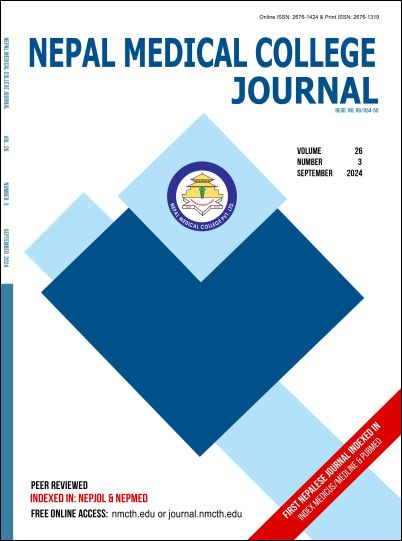Prevalence Of Metabolic Syndrome in Peri and Postmenopausal Women Aged 40- 65 Years in a Tertiary Care Centre
DOI:
https://doi.org/10.3126/nmcj.v26i3.69879Keywords:
Metabolic syndrome (MetS), perimenopausal, postmenopausal, prevalence, womenAbstract
Metabolic syndrome (MetS) is a constellation of interrelated risk factors of metabolic origin— metabolic risk factors—that appear to directly promote the development of atherosclerotic cardio-vascular disease (ASCVD). Menopausal transition with its incidental hormonal changes is considered to contribute to the development of MetS. This was a hospital based cross sectional descriptive study conducted in the Obstetrics and Gynaecology department of Nepal Medical College Teaching Hospital, Attarkhel, Gokarneshwor-8, Kathmandu, from the 1st of September 2023 till the 29th of February 2024 after clearance from the IRC (Ref. No: 56-080/081). Convenience sampling was used among women who fulfilled the inclusion criteria. The aim of the study was to determine the prevalence of MetS among the peri and postmenopausal women and to determine which component of the diagnostic criteria of MetS was more strongly associated with MetS in our population. Women were evaluated to have MetS using both the International Diabetes Federation (IDF) and the National Cholesterol Education Program- Adult Treatment Panel III (NCEP-ATPIII criteria). The prevalence of MetS by the IDF criteria was 54% among the perimenopausal women and 61% among the postmenopausal women. Similarly, the prevalence of MetS according to NCEP-ATPIII was 53.5% among the perimenopausal and 65% among the postmenopausal women. All the MetS diagnostic markers showed a strong correlation with MetS (p<0.001). The prevalence of MetS is high in our population by both the IDF and NCEP-ATP III criteria, being higher in the postmenopausal population, though not statistically significant.
Downloads
Downloads
Published
How to Cite
Issue
Section
License
Copyright (c) 2024 Nepal Medical College Journal

This work is licensed under a Creative Commons Attribution 4.0 International License.
This license enables reusers to distribute, remix, adapt, and build upon the material in any medium or format, so long as attribution is given to the creator. The license allows for commercial use.




